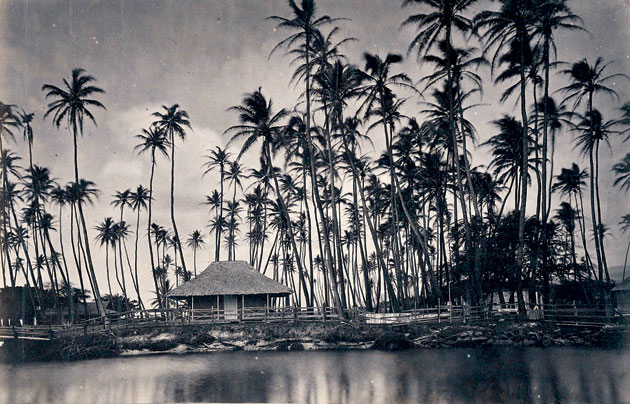Off the Beaten Path: A Royal Legacy
Some visitors may realize that Hawai’i is the only U.S. state with a palace; however, most probably don’t associate Waikiki with a royal history. The two-mile district was the landing site of the fierce warrior King Kamehameha I, who united the Hawaiian Islands after a persuasive battle at Nu’uanu Pali. For centuries, it was also the preferred playground of royals like Princess Bernice Pauahi Bishop, Queen Lili’uokalani, and Queen Kapi’olani, who was the namesake for Hawai’i’s first public park.
The agricultural pastures, the fish and taro ponds, the wetlands and the streams, that gave Waikiki its name, “spouting waters” are long gone. Still, on a glorious day in Waikiki nei, it’s not hard to see why royalty flocked to these shores the same way that throngs of tourists do today.
Waikiki’s royal ties go back to the ancient Kings of O’ahu, including Ma’ilikukahi, who ruled in the mid-1400s to 1500s, but it was Kakuhihewa, who ruled six generations after him, that is most associated with Helumoa in the central part of Waikiki, where the Royal Hawaiian Center now stands. Kakuhihewa’s encounter with a part-rooster demigod is said to have inspired the name Helumoa, which means chicken scratch.

Helumoa. Photo courtesy of Hawai’i Sate Archives
The region’s rich royal heritage and sea access may have been one of the reasons that Kamehameha I set up camp at Helumoa as his army began their conquest of O’ahu in 1795. They also established Waikiki as the first capital of the Kingdom of Hawai’i. Nearly one hundred years later, a 10,000-tree coconut grove stood at the same spot, where Princess Bernice Pauahi Bishop had a summer home. It was here in the simple grass cottage that Bishop convalesced from breast cancer and penned the codicil to her will that established schools for indigenous Hawaiian children and upon her death in 1884 made Kamehameha Schools one of the wealthiest real estate owners in the state. The Royal Hawaiian Center, the trust’s largest real estate asset, now stands on the spot.
Just across the street, an iconic banyan tree in the International Marketplace marks the spot where King William Kana’ina Lunalilo had a summer residence and enjoyed the quiet life and fishing in the area known as Kaluokau. Nearby, the beloved Princess Victoria Ka’iulani Kalaninuiahilapalapa Kawekiu i Lunalilo Cleghorn’s estate, Ainahau, was located near what is now known as the Sheraton Princess Kaiulani Hotel.
King’s Alley, the tourist-oriented complex behind the Hyatt Regency Waikiki Beach Resort and Spa, was once the home of King David Kalakaua, who was dubbed the Merrie Monarch and was the first Hawaiian king to visit the U.S. mainland. He established Kapi’olani Park, which was originally a race track and recreational area, before it was given to the people of Hawai’i for a park dedicated to his wife Queen Kapi’olani. The Waikiki Beach Marriott now stands close to ‘Ohua Street where Hawai’i’s last reigning monarch, Queen Lili’uokalani, built a home called Paoakalani on lands she called Hamohamo. While modern-day Waikiki with its mega hotels, paved roads and throngs of visitors looks very different from the lands that the ancient royals treasured, traces of their time there remain. Street names such as Kalakaua Avenue, Lili’uokalani Avenue, Kapi’olani Boulevard, Ka’iulani Avenue, Kuamo’o Street, Kalanimoku Street, and Nohonani Street bear royal names or are affiliated with their holdings. About five years ago, the Royal Hawaiian Center took its royal homage further by tearing down its concrete fortresses and reestablishing a native Hawaiian garden and cultural center in tribute to its patron Princess Pauahi. Now, it’s in the process of expanding its historic enhancements.
“We want to reawaken the stories and the presence of our ancestors via story telling, music, chant and hula,” said Manu Boyd, the cultural expert for Kamehemeha Schools and The Festival Companies. “While it’s obviously enjoyed by our malihini (tourists) and kama’aina (locals), the idea behind it is to pay honor to the land itself. Boyd points out that the “mana” or sacred spiritual force ancient Polynesian culture attached to people, places and things continues to reign over all that is Waikiki. He’s right. It doesn’t take a sovereign’s decree to realize that the essence of Waikiki—the clear aquamarine waters, the lush green foliage and the sparkling olivine-rich crater— transcends that which can be built or bought. Yes, these are the crown jewels of Hawai’i.
A three-time national award winning reporter, Allison Schaefers serves as the Waikiki Bureau Chief for the Honolulu Star-Advertiser. Based in Waikiki, she covers Hawai’i tourism and Waikiki issues. Contact her at aschaefers@staradvertiser.com.









